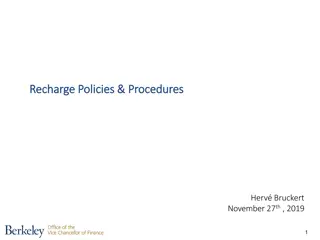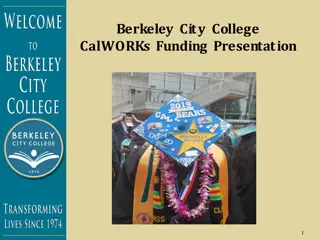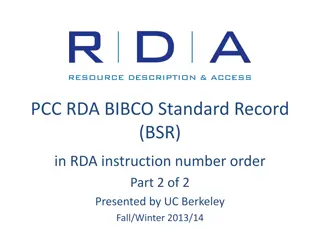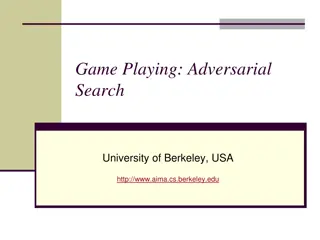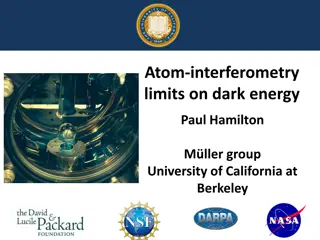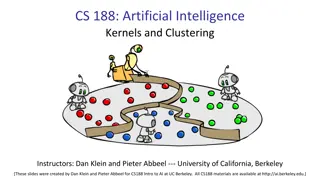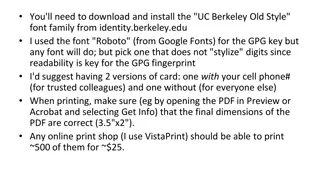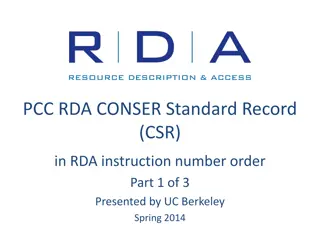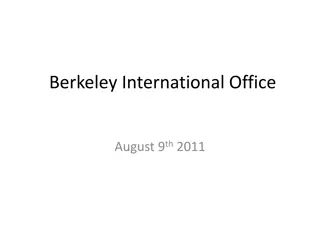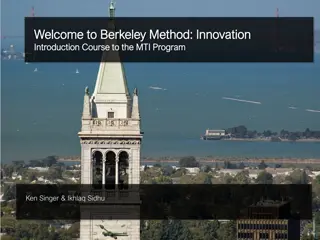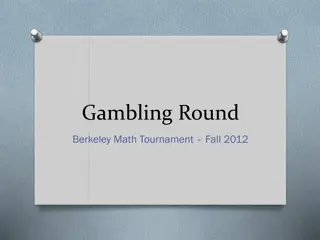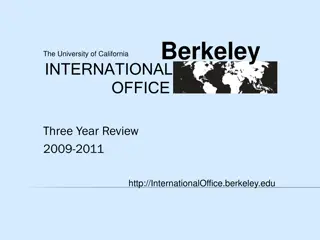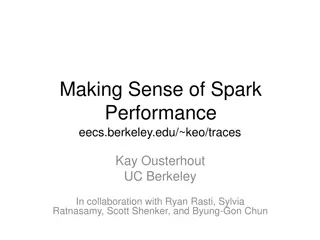Organizing Principles in Information Management at UC Berkeley
The course at University of California, Berkeley School of Information delves into the principles of organizing information. It explores how resources are selected, structured, and maintained, emphasizing the interconnected nature of organizing and describing information. Various properties and descriptions associated with resources are used as organizing principles, enabling effective information management practices. The impact of new technologies on organizing processes is also highlighted, emphasizing the need to adapt to evolving trends in information organization.
Download Presentation

Please find below an Image/Link to download the presentation.
The content on the website is provided AS IS for your information and personal use only. It may not be sold, licensed, or shared on other websites without obtaining consent from the author.If you encounter any issues during the download, it is possible that the publisher has removed the file from their server.
You are allowed to download the files provided on this website for personal or commercial use, subject to the condition that they are used lawfully. All files are the property of their respective owners.
The content on the website is provided AS IS for your information and personal use only. It may not be sold, licensed, or shared on other websites without obtaining consent from the author.
E N D
Presentation Transcript
U N I V E R S I T Y O F C A L I F O R N I A , B E R K E L E Y S C H O O L O F I N F O R M A T I O N INFO 202 Information Organization & Retrieval Fall 2013 Robert J. Glushko glushko@berkeley.edu @rjglushko 5 November 2013 Lecture 20 Midterm Review
U N I V E R S I T Y O F C A L I F O R N I A , B E R K E L E Y S C H O O L O F I N F O R M A T I O N The Course In One Slide To organize is to create capabilities by intentionally imposing order and structure We organize things, we organize information, we organize information about things, and we organize information about information If we think abstractly about these activities, we can see commonalities that outweigh their differences; We select, organize, interact with, and maintain resources We organize resources as individuals, in informal association with other individuals, or as part of a more formal institutional or business context We must recognize the profound impact of new technologies and their co-evolution with the nature of the organizing we do and the kinds of interactions that this organizing enables, but can't ignore the "classical" concepts and knowledge 2
U N I V E R S I T Y O F C A L I F O R N I A , B E R K E L E Y S C H O O L O F I N F O R M A T I O N Organizing Principles [1] ORGANIZING PRINCIPLES use properties or DESCRIPTIONS that are associated with the resources; organizing and describing resources are inherently interconnected activities Almost any property of a resource might be used as a basis for an organizing principle, and multiple properties are often used simultaneously The principles can also use collection-level properties 3
U N I V E R S I T Y O F C A L I F O R N I A , B E R K E L E Y S C H O O L O F I N F O R M A T I O N Organizing Principles [3] Other typical arrangements are based on ownership, origin, taxonomic, or taskonomic properties (usage frequency, correlated usage) Any resource with a orderable name or identifier can have alphabetic or numeric ordering Any resource with an associated date (creation, acquisition) can have chronological ordering Principles should be expressed logically in a way that doesn t assume an implementation 4
U N I V E R S I T Y O F C A L I F O R N I A , B E R K E L E Y S C H O O L O F I N F O R M A T I O N Why We Describe Resources We describe resources so we can refer to them, organize them, and interact with them Each purpose might require different descriptions and different methods of using them Different resource domains can have characteristic or standard resource descriptions (or description categories) 5
U N I V E R S I T Y O F C A L I F O R N I A , B E R K E L E Y S C H O O L O F I N F O R M A T I O N Categories are Equivalence Classes Categories are sets or groups of resources or abstract entities that are treated the same This almost never means that every instance of the category is identical It only means that for some purpose we treat them in the same way 6
U N I V E R S I T Y O F C A L I F O R N I A , B E R K E L E Y S C H O O L O F I N F O R M A T I O N Categories are Models Defining categories as equivalence classes in this way should remind you of this definition: Models are simplified descriptions of a subject that abstract from its complexity to emphasize some features or characteristics while intentionally de-emphasizing others Categories are COGNITIVE and LINGUISTIC MODELS for applying prior knowledge 7
U N I V E R S I T Y O F C A L I F O R N I A , B E R K E L E Y S C H O O L O F I N F O R M A T I O N Principles for Creating Categories Enumeration Single Properties Multiple Properties Family Resemblance Similarity Theory-Based Goal-Derived 8
U N I V E R S I T Y O F C A L I F O R N I A , B E R K E L E Y S C H O O L O F I N F O R M A T I O N Distinguishing Categorization and Classification (1) Categories are EQUIVALENCE CLASSES - sets of resources, processes, and events that we treat the same A Classification (noun) is a SYSTEM OF CATEGORIES, ordered according to a PRE-DETERMINED SET OF PRINCIPLES and used to organize a collection of resources Classification (verb) is the process of systematically assigning resources to intentional (often institutional) categories in a classification system 9
U N I V E R S I T Y O F C A L I F O R N I A , B E R K E L E Y S C H O O L O F I N F O R M A T I O N Classification Schemes A HIERARCHICAL or TAXONOMIC scheme emerges when multiple resource properties are used by organizing principles; each property creates another level A scheme can be both HIERARCHICAL and ENUMERATIVE at the lowest level where resources are categorized A FACETED classification scheme uses multiple resource properties, but does not require every resource to have a value for every property and allows the properties to be considered in any order 10
U N I V E R S I T Y O F C A L I F O R N I A , B E R K E L E Y S C H O O L O F I N F O R M A T I O N Principles Embodied in the Classification Scheme Warrant: What is the justification for the choice of categories and their names? Literary Warrant: Classify only the resources we have? Scientific Warrant: Use expert categories and names Use Warrant: Use categories and names from ordinary people Breadth and depth of classification hierarchy Degree of enumerativeness 11
U N I V E R S I T Y O F C A L I F O R N I A , B E R K E L E Y S C H O O L O F I N F O R M A T I O N Classification and Standardization (1) Classifications and standards both impose order on resources They both distinguish, explicitly or implicitly, between standard / appropriate / effective and nonstandard / inappropriate / ineffective ways of creating organizing, and using resources But this does not imply that a standard is a good one or that the best one will win a "standards war" 12
U N I V E R S I T Y O F C A L I F O R N I A , B E R K E L E Y S C H O O L O F I N F O R M A T I O N Description is Challenging People use different words for the same things, and the same words for different things - what would a "good" description be like, and how can it be created? Describing and organizing always (explicitly or implicitly) takes place in some context The context shapes which resource properties are important and the organizing principles that use those properties, introducing bias 13
U N I V E R S I T Y O F C A L I F O R N I A , B E R K E L E Y S C H O O L O F I N F O R M A T I O N The Vocabulary Problem People use a large variety of words for the same thing or concept Most people - especially system designers - are surprised by this because they think their own word choices are intuitive or "natural The extreme variability of word selection is an inescapable fact that has its roots in the nature of language and categorization 14
U N I V E R S I T Y O F C A L I F O R N I A , B E R K E L E Y S C H O O L O F I N F O R M A T I O N More than a Controlled Vocabulary A controlled vocabulary is a standardized set of terms (such as subject headings, names, classifications, etc.) assigned by organizers / cataloguers / indexers of resources A metadata schema like the Dublin Core controls the kinds of assertions about resources that you can make in the first place Controlled vocabularies can be very useful requirements or recommendations about the values that are contained in the assertions (the information content of the assertion) 15
U N I V E R S I T Y O F C A L I F O R N I A , B E R K E L E Y S C H O O L O F I N F O R M A T I O N Implications for Vocabulary Design Choosing vocabulary terms, and precisely defining their semantics, is essential but impossible to do perfectly Your vocabulary must express what YOU intend, so you "look inward" -- analyze how you think about a domain You want others to understand what you mean, so you need to "look outward" -- analyze the terms used by your users, competitors, or subject matter experts You should reuse other vocabularies or thesauri if they exist, especially for any "horizontal" components, to improve transformability and interoperability But these three approaches may suggest different terms 16
U N I V E R S I T Y O F C A L I F O R N I A , B E R K E L E Y S C H O O L O F I N F O R M A T I O N Complications The properties of resources that are easiest to describe are not always the most useful ones, especially for information resources For non-text information resources this problem is magnified because the content is often in a semantically opaque format that cannot usefully be analyzed by people. Business strategy and economics strongly influence the extent of resource description But as bibliographic collections grow larger, we need more descriptions to satify the frbr 17
U N I V E R S I T Y O F C A L I F O R N I A , B E R K E L E Y S C H O O L O F I N F O R M A T I O N The Vision of the Semantic Web (1) In a classic 2001 paper Sir Tim Berners-Lee says: The Web can reach its full potential only if data can be shared and processed by automated tools as well as by people... The Semantic Web will bring structure to the meaningful content of Web pages... For the Web to scale, tomorrow's programs must be able to share and process data even when these programs have been designed totally independently. 18
U N I V E R S I T Y O F C A L I F O R N I A , B E R K E L E Y S C H O O L O F I N F O R M A T I O N There Are No Modeling Shortcuts You might think that "modeling" means "writing a schema given a set of instances" or "inferring a schema from a single instance" (like you can with the "autogenerate" function in many XML editors) But schemas developed without a stage of conceptual design (other than very simple ones) are rarely very useful because they are too closely tied to the particular instances used, which may not be representative Sometimes schemas went through a stage of conceptual design but once the schemas are implemented the conceptual information isn't available to allow users to evaluate suitability 19
U N I V E R S I T Y O F C A L I F O R N I A , B E R K E L E Y S C H O O L O F I N F O R M A T I O N To Summarize The original vision of the Semantic Web emphasized the creation of ontologies that robustly described the semantics of particular domains or contexts Lots of research was spawned by this vision, but the high bar of formal semantics and automated agents undoubtedly deterred regular people and firms from adopting it Semantic authoring can t take off without tools that are simple to use as tools for designing and creating HTML pages 20
U N I V E R S I T Y O F C A L I F O R N I A , B E R K E L E Y S C H O O L O F I N F O R M A T I O N What's Different About Describing Multimedia? Sensory Gap Semantic Gap Proliferation Problem 21
U N I V E R S I T Y O F C A L I F O R N I A , B E R K E L E Y S C H O O L O F I N F O R M A T I O N Are these Gaps New Problems? Museums face some of the same or similar problems in describing art works and artifacts: There may be many artifacts that represent the same "work" - this is like the "sensory" gap The materials or medium in which the artifact is embodied don't convey semantics "on their surface" - this is the semantic gap There may be so many artifacts of a particular type that some get only limited descriptions - this is like the proliferation problem 22
U N I V E R S I T Y O F C A L I F O R N I A , B E R K E L E Y S C H O O L O F I N F O R M A T I O N Some Problems May Be New The temporal structure of multimedia, especially video, mandates new descriptive vocabulary and new ways to identify meaningful components Video and music meet emotional/psychological needs that are more complex than those for "documents" - so the descriptions of the latter have to be able to address these needs People don't usually access or retrieve music or video "to satisfy information requirements 23
U N I V E R S I T Y O F C A L I F O R N I A , B E R K E L E Y S C H O O L O F I N F O R M A T I O N Thing vs Type of Thing Oops... we have been blurring the distinction between individual things or instances of things and classes of things We often say that that two objects are the "same thing" when we mean they are the same "type of thing" Identifying a resource as an instance is not the same as identifying the category or "equivalence class" to which it belongs 25
U N I V E R S I T Y O F C A L I F O R N I A , B E R K E L E Y S C H O O L O F I N F O R M A T I O N Two Aspects of Thingness Two separate aspects cut across the "thingness" distinctions: Granularity Abstraction 26
Instances vs. Types 27
U N I V E R S I T Y O F C A L I F O R N I A , B E R K E L E Y S C H O O L O F I N F O R M A T I O N Design Choices & Patterns for Resources 28
U N I V E R S I T Y O F C A L I F O R N I A , B E R K E L E Y S C H O O L O F I N F O R M A T I O N Format x Focus 29
U N I V E R S I T Y O F C A L I F O R N I A , B E R K E L E Y S C H O O L O F I N F O R M A T I O N Interactions The Why of Organizing Systems INTERACTIONS include any activity, function, or service supported by or enabled with respect to the resources in a collection or with respect the collection as a whole Interactions can include access, reuse, copying, transforming, translating, comparing, combining anything that a person or process can do with the resources 30
U N I V E R S I T Y O F C A L I F O R N I A , B E R K E L E Y S C H O O L O F I N F O R M A T I O N Interactions Some interactions can be enabled with any type of resource, while others are tied to resource types Interaction can be direct, mediated or indirect, or limited to interactions with resource copies or descriptions The supported interactions depend on the nature and extent of the resource descriptions and arrangement Different principles, or different implementations of the same organizing principles, determine the efficiency or effectiveness of the interactions 31
Interaction and Value Creation Interactions differ in the absolute and relative amounts of physical manipulation, interpersonal or empathetic contact, and symbolic manipulation or information exchange involved in the interaction Physical Object Manipulation Symbolic Manipulation Interpersonal Interaction Apte, U. and Mason, R. Global Disaggregation of Information-Intensive Services. Management Science (1995). 32
Value Creation with Smart Resources The variety and functions of interactions with digital resources are determined by the amount of structure and semantics represented in their digital encoding, in the descriptions associated with the resources, or by the intelligence of the computational processes applied to them 33
U N I V E R S I T Y O F C A L I F O R N I A , B E R K E L E Y S C H O O L O F I N F O R M A T I O N The Document Type Spectrum From Glushko & McGrath, DOCUMENT ENGINEERING, MIT Press 2005 34
U N I V E R S I T Y O F C A L I F O R N I A , B E R K E L E Y S C H O O L O F I N F O R M A T I O N Five Perspectives on Relationships (1) SEMANTIC: the meaning of the association LEXICAL: how the conceptual description of a relationship is expressed using words in a specific language STRUCTURAL: analyzes the patterns of association, arrangement, proximity, or connection between resources 36
U N I V E R S I T Y O F C A L I F O R N I A , B E R K E L E Y S C H O O L O F I N F O R M A T I O N Five Perspectives on Relationships (1) ARCHITECTURAL: emphasizes the number and abstraction level of the components of a relationship, which together characterize its complexity IMPLEMENTATION: how the relationship is implemented in a particular notation and syntax and the manner in which relationships are arranged and stored in some technology environment. 37
U N I V E R S I T Y O F C A L I F O R N I A , B E R K E L E Y S C H O O L O F I N F O R M A T I O N Defining "Relationship" An association among several things, with that association having a particular significance Relationships are the stuff out of which information is made The reason is an important part of the relationship Multiple relationships can exist among the same objects, so the order of the objects matters 38
U N I V E R S I T Y O F C A L I F O R N I A , B E R K E L E Y S C H O O L O F I N F O R M A T I O N The Structural Perspective on Relationships Analyzing the association, arrangement, proximity, or connection between resources without primary concern for their meaning or the origin of these relationships Sometimes structure is all we know...and sometimes we ignore what we know about relationship semantics to focus on the generic aspect of structural connectivity 39
U N I V E R S I T Y O F C A L I F O R N I A , B E R K E L E Y S C H O O L O F I N F O R M A T I O N Internal and External Structure Resources can have INTERNAL structure as well as EXTERNAL structure that connects them to other resources We often make arbitrary decisions about how the granularity with which we describe the internal structure of a resource The boundaries we impose to identify resources determines whether some structure is internal or external with respect to them 40
U N I V E R S I T Y O F C A L I F O R N I A , B E R K E L E Y S C H O O L O F I N F O R M A T I O N The Architectural Perspective {and,or,vs.} the Structural Perspective The architectural perspective is abstract and prescriptive It defines what kinds of relationships can be created The structural perspective is concrete and descriptive one It says "this is what exists" and describes the actual patterns of association, arrangements, proximity, or connection between resources" 41
U N I V E R S I T Y O F C A L I F O R N I A , B E R K E L E Y S C H O O L O F I N F O R M A T I O N Computing the Properties of Graphs Reachability is there a path between any two nodes in the graph? Shortest path if there are multiple paths between two nodes, which is the shortest? Centrality which nodes are the most connected or have the average shortest paths to the other nodes? Subgraph discovery are there sub-graphs that are completely contained in a larger graph? 42
U N I V E R S I T Y O F C A L I F O R N I A , B E R K E L E Y S C H O O L O F I N F O R M A T I O N The Conceptual Model of Social Tagging 43



